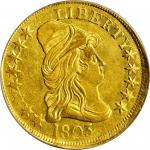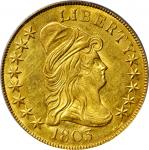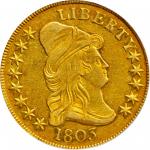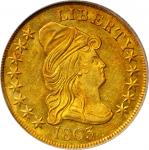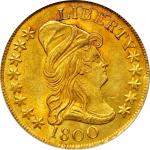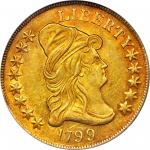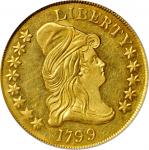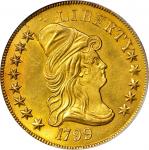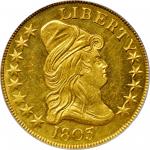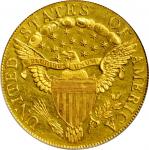1803 Capped Bust Right Eagle. BD-3, Taraszka-28. Rarity-4. Small Reverse Stars. MS-61 (PCGS).Type and Style: Type II: Capped Bust Right, Heraldic Eagle. Style VII: Head of 1795 with 13 large stars arranged eight left, five right; Reverse of 1799 with 13 small stars in the field below the clouds and a short, thick neck on the eagle. The head and eagle punches are attributed to hubs prepared by Robert Scot.Die Variety: BD-3, Taraszka-28, Breen 1-A, HBCC-3197. This variety represents the third of six uses of this obverse die, the only one of the 1803-dated issue, and the second of two uses of this reverse die. On the reverse, which was first used in the 1801 BD-2 marriage, the right edge of the letter E in STATES is centered over a space between two clouds and the end of the branch stem is long and curves down.Die State: BD Die State c/d. This is the later of only two known die states for this variety, although theoretically a terminal state of the reverse should exist since the 1803 BD-3 represents its only use. The obverse was inherited perfect from its previous uses in the 1803 BD-1 and BD-2 pairings, but in this later state light clash marks from the horizontal stripes in the reverse shield are evident within the strands of Libertys hair around the ear. The reverse was inherited from the 1801 BD-2 marriage, as above, but in its earlier state in the 1803 BD-3 pairing (Die State c) light cracks are now evident through the top of the letters IT in UNITED and from the ribbon past the latter M in UNUM to star 6. In this later Die State d, the reverse was relapped to efface clash marks from Die State c and has clashed again with particularly prominent clash marks around star 1, the eagles head, the upper left corner of the shield, between the eagles right wing and the arrow heads, and between the eagles left wing and the olive branch. Lapping has effaced part of the cloud below the letter A in STATES and truncated many of the dentils around the border.Estimated Mintage for the Issue: According to Walter Breen, the mintage for the 1803-dated eagle is 15,017 coins, divided into 8,979 pieces for the Small Reverse Stars Guide Book variety and 6,038 coins for the BD-5 Large Reverse Stars, Extra Star die pairing. Most numismatic references, including the Guide Book, have long accepted this figure for the 1803 eagle. The author further divides the Small Reverse Stars mintage into 4,816 coins delivered on August 19, 1803 and 4,163 coins delivered on November 19, 1803. Breen attributes the 6,038 eagles delivered from June 1 to December 11, 1804 to the BD-5 Large Reverse Stars, Extra Star variety. Dannreuther, however, provides a range of 13,850 to 20,450 eagles struck from 1803-dated dies, the higher estimate likely closer to reality since we know that the 1803 BD-6 is a backdated variety struck after the 1804 BD-1 and, hence, is not included in Breens estimate given above.Estimated Mintage for the Variety: Dannreuther estimates that 7,500 to 10,000 examples were coined from the 1803 BD-3 dies.Estimated Surviving Population for the Variety: One hundred fifty to 200 coins are believed extant in all grades (per Dannreuther).Strike: This appealing early eagle exhibits sharp to full central striking detail that softens in isolated areas toward the borders. The individual strands of Libertys hair and the eagles breast, tail and most of the wing feathers are particularly noteworthy for crispness of detail. Around the peripheries, we note softness of detail to all stars on the obverse except for 9, 10 and 11, both of the eagles wing tips, some of the letters in the legend UNITED STATES OF AMERICA, the clouds below the word OF, and the eagles right talon. A few prominent adjustment marks (as made) through the eagles wing tips help to explain the softness of detail in those areas. The strike, however, is well centered with fully and uniformly denticulated borders framing both sides.Surfaces: Beautiful bright gold surfaces are semi-prooflike in finish with appreciable reflectivity in the fields. The appearance is quite smooth for the assigned grade with only light, wispy hairlines that are easily overlooked. The most useful identifying feature is a tiny, shallow planchet void in the lower left reverse field before the letter U in UNITED.Commentary: With up to 200 coins believed extant, BD-3 handily outdistances BD-5 to rank as the most available of the six known die marriages of the 1803 eagle. Given the extant population it is surprising that a terminal reverse die state coin has not been found, leaving us to wonder about the exact nature of the damage that retired this otherwise hardy die. (This reverse had previously struck 30,000 to 40,000 coins in the 1801 BD-2 pairing, followed by 7,500 to 10,000 coins in the 1803 BD-3 marriage represented here -- an unusually large number of coins for an early eagle die.) The obverse die, of course, was nearly as hardy, being used for all six varieties of the 1803-dated issue.Given its relative availability, the 1803 BD-3 is one of the more popular type varieties in the Capped Bust Right Eagle series, often selected to represent the Heraldic Eagle reverse design. Of course, no pre-1834 U.S. Mint gold issues or varieties can rightly be called common in an absolute sense. All are scarce, and many are downright rare. The 1803 BD-3 eagle falls into the former category in terms of total number of coins extant, the present Mint State survivor rare from a condition standpoint and worthy of inclusion in an advanced collection.From the Anthony J. Taraszka Collection. Acquired from Mid-American Rare Coin Galleries at the Detroit ANA Convention, August 1994. The plate coin for the die variety in the book United States Ten Dollar Gold Eagles: 1795-1804 by Anthony J. Taraszka.

